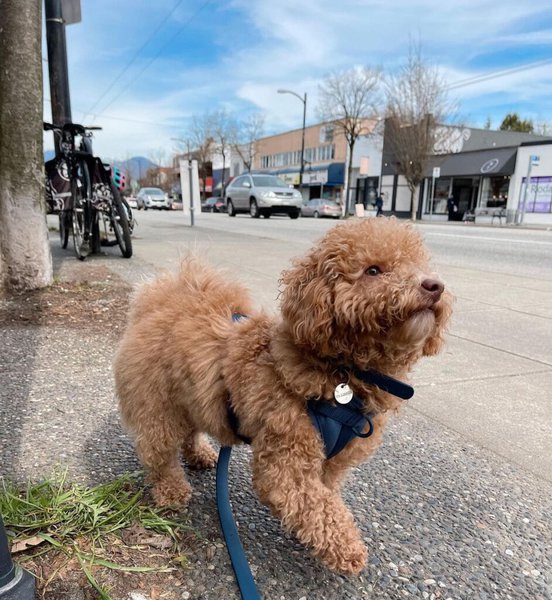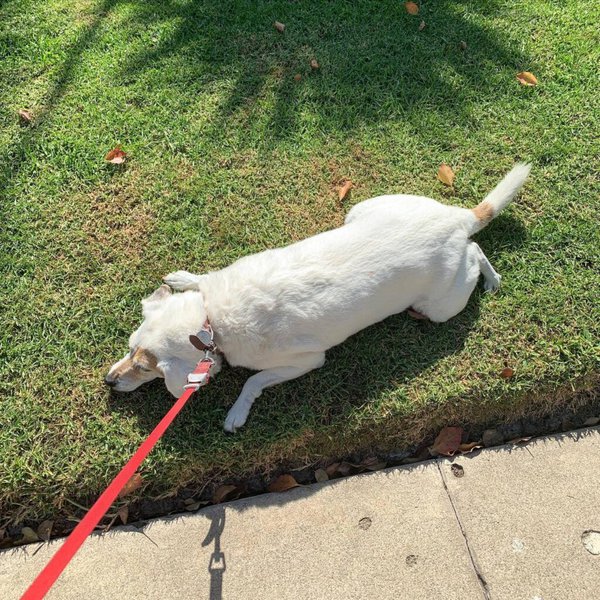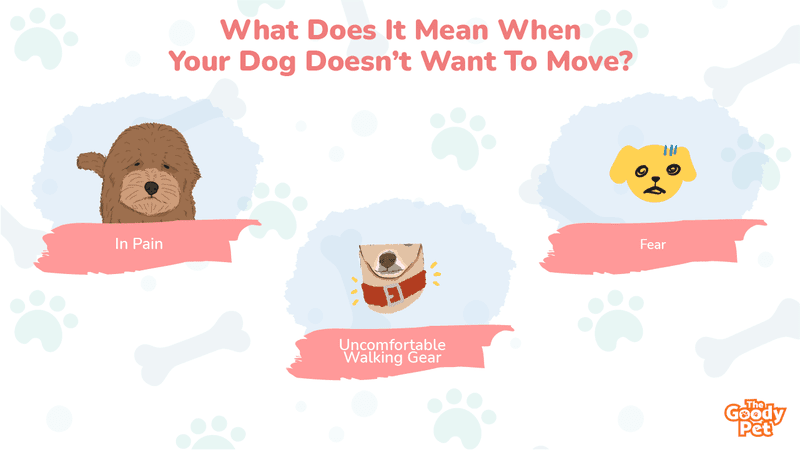For the umpteenth time, your doggie has frozen at the exact same spot, while out on a walk, and you’re losing your mind having to repeatedly drag your pooch home. But, have you ever considered the fact that your dear fido may be trying to tell you something?
A dog may stop walking and refuse to move because it might be in pain from an injury or illness, fear of something or someone in its environment, had undergone poor leash training, or is feeling uncomfortable in its walking gear. In the same vein, a doggie may refuse to move when it’s time to go home because it’s having fun or simply because it’s too tired to move!
As a pooch owner, understanding the reason for your doggie’s sudden refusal to move, along with tips on what to do when confronted with such a situation are must-have weapons in your canine arsenal. But before we delve into all this, let’s see why a doggie may stop walking and refuse to move.
What Does It Mean When Your Dog Doesn’t Want To Move?
It is said that there can be no fire without smoke, and there’s a myriad of reasons your pooch may seemingly stop wanting to move all of a sudden.
Some of the more common reasons dogs may suddenly refuse to budge while on walks include:
Your Dog May Be In Pain
When your dog suddenly doesn’t want to move, it can be a sign that your pooch is in pain from an underlying health condition or physical injury; And this is particularly true for previously active pooches that have developed a sudden aversion to moving around.
Knee pains, back pains, or an injury to the paw or legs are some common reasons a doggie may express a reluctance to move. In the same vein, a pooch refusing to move may be suffering from a mild form of paralysis, arthritis, or hip dysplasia.
Fear
Your dog may also stop and refuse to move while on walks because it’s scared of something in its immediate environment.
This fear may stem from moving to a new neighborhood, previous trauma from going on walks, or anxiety from the introduction to a lot of unfamiliar faces, smells, and sights at once.
Along with a refusal to move, a scared doggie will have its ears laid back, tails tucked, and crouch to firmly plant its forelegs in the ground.
Lack Of Proper Leash Training
If your doggie refuses to move while on a leash, but will happily prance around like a horse without the leash, it can be that you’ve not given your pooch the appropriate leash training.
Doggies aren’t born to walk on restraints, and a pooch that hasn’t been properly introduced to the rein will always display an aversion to going on walks with leashes.
Your Doggie May Want Something From You
If your pooch suddenly stops moving and lies upside down, it can be that your doggie wants a belly rub from you. Alternatively, your pooch may not feel up to taking a walk and may stop walking at intervals to express its displeasure.
In the same vein, when your dog refuses to move and lays down to play dead when it’s time to go home from a walk, it can be an indicator that the doggie is having the time of its life, and is not ready to go home just yet.
Tiredness
Sometimes, the reason for your dog’s refusal to move may not be far-fetched, and it can simply be that your pooch is tired; This can be the case if you’re taking long walks with your furry friend or if you’ve been exercising your doggie for too long.
Uncomfortable Walking Gear
When your pooch refuses to stop moving while you’re walking it on a leash, it can be because the walking equipment is making your furry friend uncomfortable. If the collar straps are pinching or scratching your furry friend, it may result in a refusal to move.
Additionally, your pooch may have unpleasant memories of being put on leashes and collars and will refuse to walk when put in one.
What Do I Do If My Dog Stops Walking And Won’t Move?
Check To Ensure That Your Dog’s Leash Is Comfortable
One of the first things to do when your dog stops walking is to examine your pooch’s leash and collar to ensure that it’s not the cause of your doggie’s reluctance to walk.
Check to make sure that the collar isn’t too tight, that the buckles aren’t cutting into your doggie’s skin or that the walking harness is properly fitted on your dog. You should also adopt the use of walking gear that is relatively light and comfortable for your pooch to carry.

Examine Your Dog For Signs Of Injury
As stated earlier, refusal to move can be an indicator that your pooch is in pain. And immediately you notice that your dog has stopped walking and won’t move, you should examine its body for physical signs of injury.
If you notice signs of injury in your Fido, you should immediately try to calm it down and take it for the appropriate treatment.
A Visit To The Vet May Be Necessary
It may be difficult to diagnose dogs suffering in pain from medical conditions by mere physical scrutiny. And in such cases, you must take your doggie to your veterinary doctor for a thorough examination and diagnostic tests.
Once the necessary tests have been run, and the cause of your pooch’s pain identified, your vet can then proceed to recommend the appropriate form of treatment and medication to get your furry friend walking again.
Identify And Eliminate Fear Triggers
If a medical condition or physical injury has been ruled out as the cause of your dog’s refusal to move, you can try to determine fear triggers that may cause your pooch to freeze and stop walking. These triggers vary and they may include an intimidating human presence, another dog, physical barriers, or even the garbage can in the corner!
Understandably, this process may take a significant amount of time due to the limitless number of objects and scenarios that can induce fear in your pooch. But once you’re able to successfully discover and find solutions to fear triggers in your pooch, you can enjoy long, exciting walks with your furry friend.
Leash Training
For dogs that haven’t been properly introduced to the leash, you can start by properly training your dog to walk on leashes as a means of combating refusal to walk.
Start by gradually introducing your pooch to the collar, and allow it to wear around the house for short periods. You should also practice walking your pooch on a leash around the house. And it’ll help to associate the wearing of the leash collar with treats and gifts for your doggie.
Once your furry friend seems comfortable enough walking on a leash indoors, you can take the giant step and try walking your pooch outdoors. It is imperative that you keep the first walks brief and limited to relatively quiet areas to enable your doggie to get familiar with the intricacies of the outside world.
How Do You Walk A Stubborn Dog?
Once you’ve ruled out a medical or behavioral issue as the cause of your doggie’s reluctance to walk, there are several training methods you can employ to get a stubborn dog to start walking more freely.
Some of these training methods include:
Use Of Positive Reinforcement
One method that certainly never fails to shape your dog’s behavior, if done properly, is the use of positive reinforcement. And it is with this that you can successfully convince a stubborn dog to go on long, exciting walks.
Using positive reinforcements to get a stubborn dog walking should involve the use of the pooch’s favorite treats, toys, and words of praise and endearment for every couple of steps your doggie takes. With time, your stubborn dog will come to associate walking with the presence of treats and will be much more eager to go on walks.
Teaching Your Dog To Walk On Cue
This training method also involves the use of positive reinforcement, but it is combined with either verbal or non-verbal cues intended to get a stubborn dog walking.
To teach a dog to walk on cue with a leash:
- Familiarize your pooch with the collar and leash by regularly attaching the lead to your dog during indoor play activities; This can be during a game of chase of fetch.
- Ensure your dog’s attention is not solely on the leash by providing lots of treats and toys to keep it distracted.
- Once your dog gets used to the idea of playing on a leash, make noises during play sessions to get your dog’s attention; Ensure you keep the leash slack while doing this.
- If your dog starts walking towards you as a result of the noises you’re making, offer it treats and shower it with words of praise as encouragement for it to keep coming.
- Walk away from your dog as it walks towards you.
- While walking away from your dog, chip in a cue word along with the use of treats to keep your doggie moving; This cue word can be anything, but you have to ensure it is short and catchy enough for your pooch to remember easily.
- Constantly practice the aforementioned processes.
- Once your dog becomes more comfortable with the idea of walking towards you while on a leash, you can begin taking it for walks outdoors.
Taking Charge
For a dog that enjoys pulling and going away on its while on walks, you have to effectively take charge of the doggie’s pulling, and at the same time remind it who’s boss.
- Once your dog starts pulling away while you’re walking it on a leash, stand firm and ensure that you don’t move in the direction your pooch wants to go.
- Make sure to stand your ground, and be prepared to wait for as long as it takes.
- Once your pulling dog turns around to see what the problem is, lure it towards you with a treat.
- Immediately your doggie arrives at your side, offer it the treat and encourage it to start walking forward again.
- Repeat the processes listed above anytime your dog stops walking and starts pulling or lunging away.
What If Your Dog Refuses To Walk After Training?
If a trained dog is not feeling up to a walk, the best thing to do, after ruling out potential medical and physical issues, is to leave such a dog be, and not force it to go on walks with you.
Additionally, you should endeavor to provide such a doggie with the required amount of care and attention, till it’s ready to hit the road again.
Can A Dog Walk Too Much?
Taking your dog on daily walks is important to maintain fitness levels, prevent boredom and keep your pooch mentally stimulated. But while it may seem as if they have limitless energy levels, the truth is, some dogs can get tired and worn out from repeatedly taking long hikes.
How Do You Know If A Dog Is Tired From Walking Too Much?
If your dog is not used to going on long walks, it may express its displeasure and indicate that it’s tired by refusing to move while on walks. And along with a refusal to budge, some other signs you can observe to determine if your furry friend is tired while taking a walk include:
- Yawning.
- Refusal to obey commands.
- Excessive panting.
- Sniffing the ground.
- Lying down.
- Increased lip licking.

How To Ensure Your Dog Doesn’t Get Tired While Walking?
As a rule of thumb, you should take your dog on short, 15-minute walks, either 3 or 4 times per day. However, this can vary depending on your doggie’s breed, size, age, and physical and health condition.
Once you notice signs of tiredness in your pooch while out on a walk, the best thing to do is to take a short rest to enable your doggie to regain its strength. It can also help to take a water bottle along with you on your walks to rehydrate and invigorate your dog.
Varied walking can also help to ensure your dog doesn’t get tired while walking; This can be achieved by walking fast for some time and then reducing the walking speed at regular intervals.
Walk When The Weather Is Cool
You should have it at the back of your mind that taking your dog out on a walk when the temperature is hottest can lead to overheating and fatigue. And this, in turn, may lead to your doggie’s refusal to walk. To avoid this, only take your dog on walks when the weather is relatively cool – early in the morning or late afternoons/evening.
In the same vein, avoid taking your pooch on walks when temperature levels are dangerously low.
Related Questions
What Does It Mean When Your Dog Suddenly Can’t Walk? When your dog suddenly can’t walk, it can be a sign that it is in pain from a physical injury or suffering from an underlying medical condition. Other reasons your dog may freeze while walking includes fear and anxiety, tiredness from too much exercise, or inadequate leash training.
How Do I Get My Dog To Walk On A Leash Without Pulling? You can get your dog to walk on a leash with proper leash training or with the use of special dog-walking harnesses. Alternatively, when your dog pulls while on a walk, you should stop moving immediately, and offer the doggie a treat when it moves at a normal walking pace.
Why Is My Dog Having Trouble Getting Up? The most common cause of a dog’s back legs suddenly giving out, thereby leading to trouble getting up, is due to back leg weakness resulting from either arthritis, injury, cancer, poisoning, or an inherited genetic condition. Back leg weakness is often common with senior dogs.





